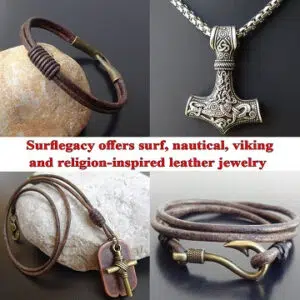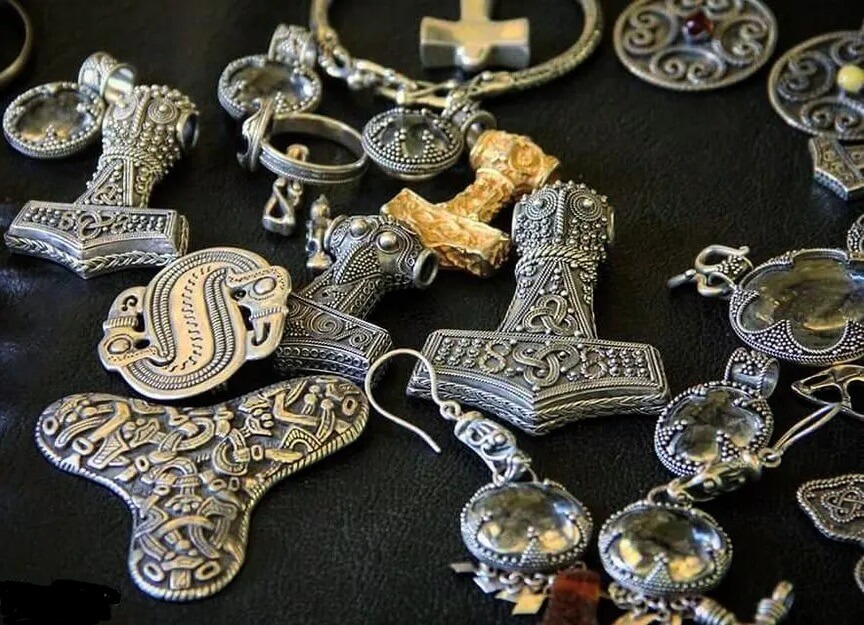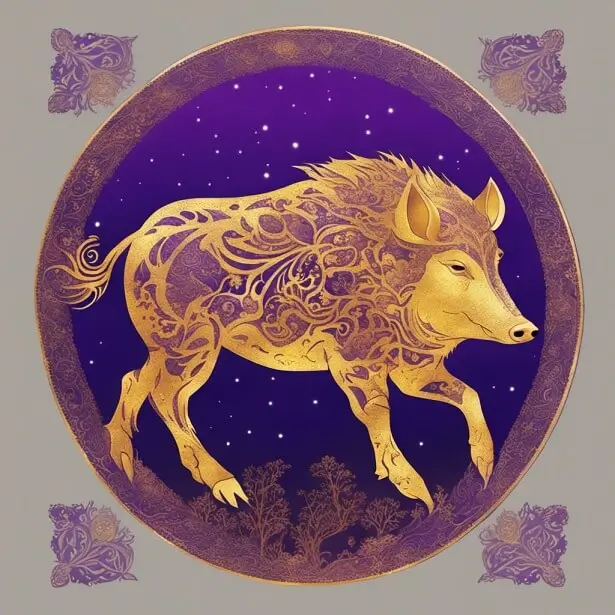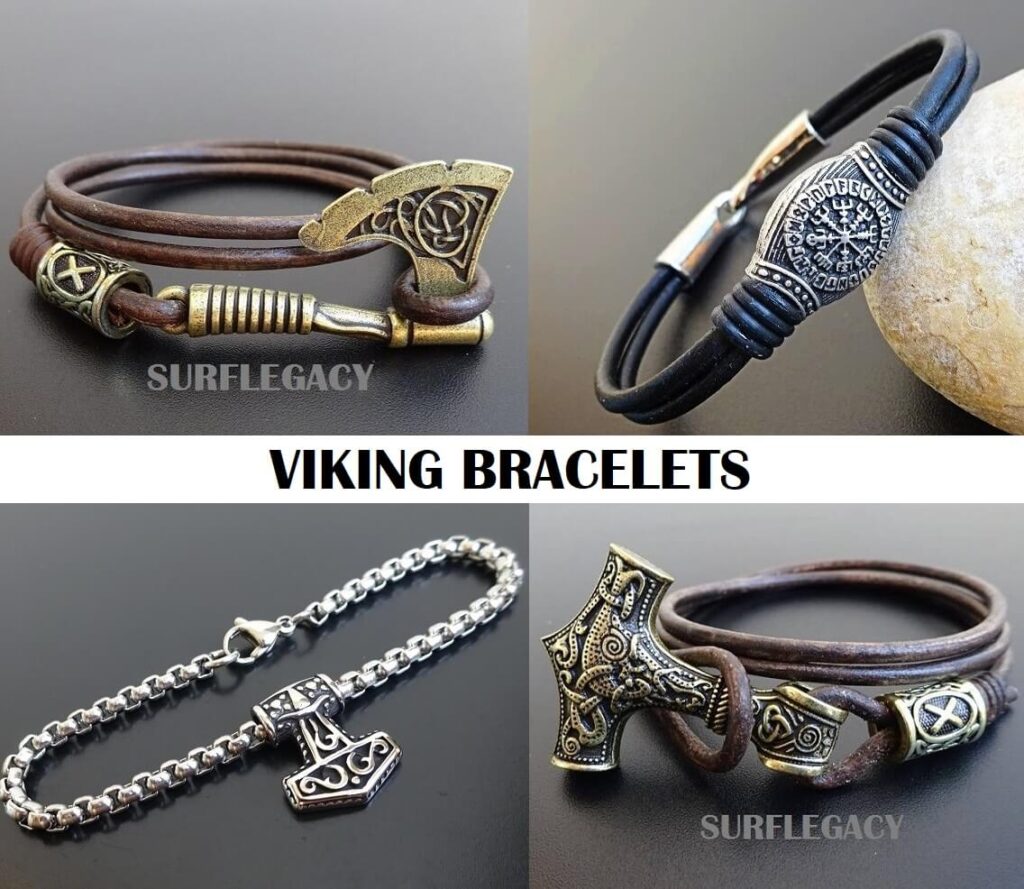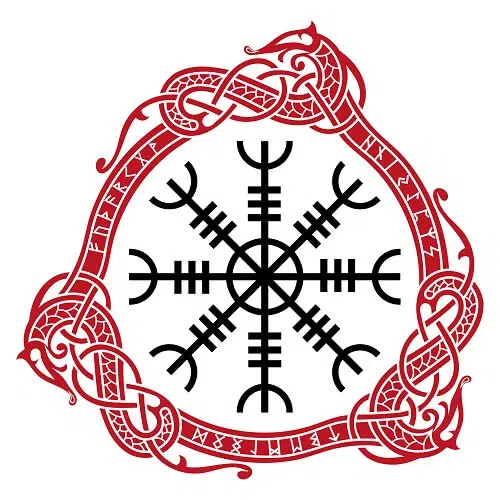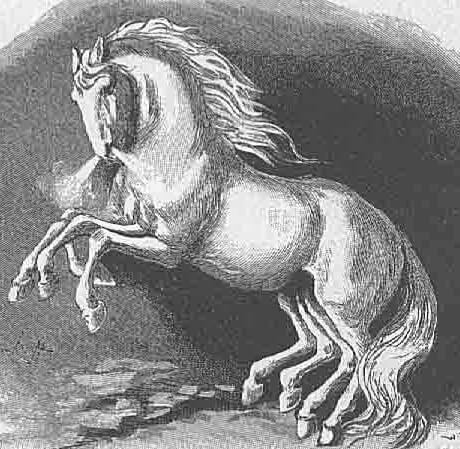In popular belief, Vikings have often been depicted as rough, violent, and dirty people, sometimes with beards and long hair. As we have seen in previous articles, this folkloristic description often did not represent reality.
As demonstrated by the many artifacts found, Vikings were also a people of refined tastes, elegant, dedicated to trade with the most powerful nations of the time, the Holy Roman Empire, the Arabian Empire, and the Byzantine.
A people who, thanks to the Drakkar, the flat-keeled ships, could navigate the open sea as well as along the rivers with shallow draft making explorations in Greenland, Iceland, and reaching the coasts of North America a few centuries before Columbus.
That of the Vikings is an era known as the Golden Age and unfolds between 750 and 1050 AD. During these three centuries, Scandinavian societies expanded their economy and knowledge, and from the 11th century, absorbed Christian influences.
A brief history of Viking Jewelry
The history of Viking jewelry is long and detailed. It is believed that the first Viking jewelry was created in the 8th century. The Viking rings were a group of people who lived in Scandinavia. They were known for their skill in warfare and their love of adventure.
They also had a reputation for being great craftsmen. The Viking bracelets were known for their beautiful Jewelry. They appreciated elegance and refinement, and the Jewelry testifies that their society was not only dedicated to raiding, sexual or food enjoyment.
The proof is the discovery of Norse Jewelry, beautiful Viking bracelets, gold and silver necklaces exhibited at the Vikingr exhibition in Oslo in 2020. Extremely elaborate artifacts of French, Russian and English manufacture, probably the result of an exchange that took place in 858 thanks to which the Carolingian Franks paid with this treasure the liberation of the bishop of St. Denis and his son
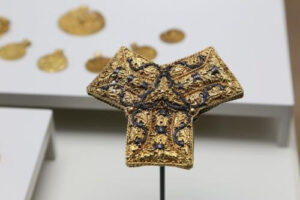
Viking Jewelry exhibited at Oslo Museum in 2020
How is Viking Jewelry made?
The art of making Viking necklaces jewelry is a very intricate and detailed process that takes many years to perfect. It begins with selecting the materials that will use gold, silver, and bronze, the most common materials used in Viking jewels.
Once the materials have been selected, the next step is to create the design. Skilled crafts usually create the design with years of experience making Viking jewelry artifacts.
Vikings were skilled craftsmen. The gold and silver came from the foreign coins obtained through trade or raids, they were melted and shaped, working with a hammer or melting tool, and poured into molds of wax, wood, and clay and were used to make various everyday objects and Jewelry.
Each of their creations was then covered with designs and elaborate carvings, authentic Viking jewelry collection was often decorated with symbols such as animals, plants, or geometric shapes. They used more techniques to make a jewel or an object unique and distinguishable, for example, some brooches were made with materials of irrelevant value, and they carved them creating designs, then inside them were beaten metal wires and then everything was polished.
They were not only skilled with metals, they were also good with other materials such as stone, which was engraved and worked, and finally wood, which was very used, they chiseled, engraved and polished creating masterpieces.
Some jewelry themes was created using the “lost wax” method, in which a mold is made of the piece and then the metal is poured in. Once cooled, the wax was broken off and the metal polished. Norse Jewelry was of various types and was worn by people of both sexes.
The meaning of Viking Jewelry
The meaning behind is very complex and varied. It can be seen as a reflection of the Viking culture and Val and as a way to show wealth and status. Viking jewelry range was often made from precious metals and stones and was often very intricate and detailed. It was also used as a way to show allegiance to a particular chieftain or clan.
Viking Jewelry and Social Status
It was not only purely aesthetic, but also a matter of social status and spiritual belief. Most people wore brooches of bronze and silver pieces, although the wealthiest also wore gold. Jewelry was often given as a gift or used to show status, wealth, or power and to signify rank in society; in many cases was often passed down from generation to generation.
Vikings loved Jewelry, evidenced by the fact that they used to decorate not only their clothes, shields, and bodies, but also their houses, ships, and even their weapons with intricated designs, including animals, plants, and geometric patterns.
Jewelry was not only used for pure decoration, but also as a form of payment in trade. Because Jewelry is made of precious metals, like silver or gold, it was frequently used as a form of currency and was dubbed “hack silver” due to its specific purpose. People from the lower classes made Jewelry out of animal bones and wood.
How is Viking Jewelry used?
Vikings used a wide range of Jewelry, just as we do today. Jewelry was designed both for aesthetics and as an exchange for money, finally, it was common for Vikings to wear symbols that also had personal or religious significance.
Rings were worn as a sign of wealth and status, while necklaces and bracelets were often used to ward off evil spirits. Amulets were also popular and were often inscribed with runes or other magical symbols.
Pendants were another common type of Viking jewelry, and were often used to show allegiance to a particular god or goddess, such as Thor’s hammer – also called Mjolnir – is thought to be the most common piece of Jewelry. Made in honor of Thor (Odin ’s son) the God of thunder and lightning one of the major deities in Norse Mythology, this pendant was often worn for protection during battle.
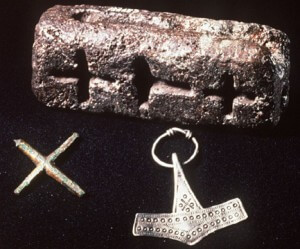
Mjolnir artifact
The most popular designs are those that are inspired by Norse mythology and Celtic culture. Popular designs include dragons, wolves, and other animals that were considered to be sacred in Norse mythology.
Other popular designs include runes used as a form of writing in the Viking age and Celtic knots used as decoration in many Viking artifacts. All of our current knowledge of precious Nordic Jewelry comes from archaeological excavations.
Archaeologists have discovered that both Viking men and women wear Jewelry.
The majority of Viking women wore necklaces with animal motifs and brooches on their dresses which were considered part of their attire. Necklaces, bracelets, hand and foot rings, bangles, amulets, pendants, armbands, beads, brooches, and even earrings were all styles of unique Jewelry pieces worn by the Vikings on the neck, wrists, or arms.
The Different Types of Viking Jewelry
Necklaces and Pendants
Necklaces worn by men were made of metal bars twisted together called Torcs, sometimes adorned with a gemstone, amulet, or pendant; women’s necklaces, as mentioned, were more elaborate.
Rings differed between men and women only in size, as did bracelets, although both bracelets and armbands (thicker bracelets) appear to have had ceremonial and social significance.
Among the most popular examples of Jewelry, in addition to brooches, were pendants with very different shapes.
Usually, they were in honor of the gods, so they could be in the shape of a throne, a horse in honor of Odin’s steed Sleipnir, or weapons associated with various deities, among which, of course, the most popular was Thor’s hammer alias the Mjölnir: this was not only considered an amulet of protection against threats but a source of strength to which a person could draw during the vicissitudes of life.
Among the most common Jewelry worn by the Vikings were pendants of religious symbols that had meaning to the wearer.
Mjolnir
The symbol certainly by far the most popular among the Vikings was the Mjolnir. Among the archaeological finds is certainly one of the most frequent objects found in burial sites and that shows how widespread it was among the Vikings
Mjolnir was a symbol of protection, as Thor was the designated protector of Midgard and Asgard against the chaotic forces of the giants. It also symbolized the strength of the wearer, as Thor was considered the strongest and best of all warriors.
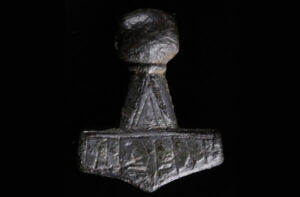
Viking Arm Rings
Aside from these pendants, the most common piece of Jewelry among Viking men were arm rings, which were basically bracelets made of gold, silver, or leather. Arm rings made from precious materials were also used as currency. Vikings often cut pieces of precious metal from their ring and used them as a form of payment.
These arm rings were important symbols of social status. They were exchanged between allies, and wealthy lords often gave these rings to their warriors to ensure their loyalty.
The Norse bracelet was essentially a coin purse. It was designed to be easily folded and to be able to offer a piece in exchange for goods or services. The bracelet also symbolized the transition from boy to man or could be given as a gift from someone of a higher social class toward one of his subordinates. An example is the figure of King Hrothgar in Beowulf, known as the “ring giver” – a generous gentleman who dispensed gifts to those in his good graces.
Viking brooch
Probably the most common piece of Viking Jewelry worn by women were brooches, which were used to hold the straps of their dresses in place. Men also often used brooches to secure their cloaks on their shoulders.
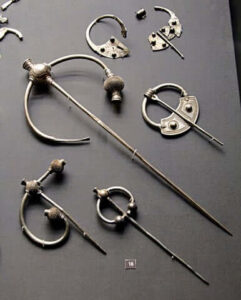
Viking brooches
They were usually made of bronze, and while they tended to be oval-shaped in the ninth and early tenth centuries, disk-shaped brooches were more popular in the second half of the tenth century.
In his book “Everyday Life During the Extraordinary Era of the Norsemen,” Wolf comments on the popularity and necessity of brooches: “Brooches were what we might call a must-have piece of Jewelry, as they had the function of securing clothing.
Many have been found, from unique pieces made of precious metals to mass-produced pieces made of low-cost materials. The latter were often covered on the surface to give them the appearance of gold or silver.
The oval brooches, dome-shaped, used by women to stop the clothes are the most common. Worn in pairs, they usually measure 10-12 cm, with conspicuous decorations in relief and sometimes adorned with filigree. They are generally decorated with motifs of intertwined animals.
What is the difference between Viking Jewelry and other types of jewelry?
Viking jewelry is specifically designed to be worn by people of Viking descent. This type of Jewelry is often made from materials that are specific to the Viking culture, such as silver, bronze, and iron. Viking Jewelry is also often decorated with symbols that are significant to the Viking people, such as dragons, ravens, and wolves.
How do I know if Viking Jewelry is right for me?
This is a difficult question to answer, as it depends on many factors. Some people may feel drawn to Viking jewelry because of their cultural heritage, while others may simply appreciate the unique and intricate designs.
If you’re unsure whether Viking jewelry is right for you, it’s worth doing some research to learn more about the history and meaning behind these pieces. You may also want to consult with a jewelry expert to get their opinion on which pieces would suit you best.
What are some tips for wearing Viking Jewelry?
Assuming you are asking about modern Viking jewelry: Viking jewelry is often very ornate and eye-catching, so you want to make sure that it is the focal point of your outfit. Pairing it with simple, understated clothing is usually the best way to go.
Avoid wearing too many other pieces of Jewelry with your Viking jewelry, as it can look cluttered and take away from the impact of the piece.
Vikings used a wide range of Jewelry, just as we do today. Jewelry was designed both for aesthetics and as an exchange for money, finally, it was common for Vikings to wear symbols that also had personal or religious significance such as the Mjolnir hammer.
Modern Viking Jewelry
Modern Viking jewelry includes charms, necklaces and bracelets made with materials like stainless steel, pewter, bronze or sterling silver. Viking symbols include Vegvisir, Fenrir, the Viking axe, Gungnir, helm of awe, Yggdrasil, Raven skull, Huggin and Muninn, Thor’s hammer pendant, Viking runes, and beard beads are the most popular ones.
Where can I purchase Viking Jewelry?
There are many places where you can shop for Viking products. Online, at a local jeweler, or at a store that specializes in selling Norse jewelry.
Surflegacy, is your premier destination for high-quality handmade Jewelry. If you are looking for some unique Viking, Surf, Nautical, Animal or Religious-inspired handmade jewelry and have gone through dozen of websites in search of the ideal design and price range, then you have come to the right place.
Our pieces are crafted in Italy, with care, love, and style in mind, our main goal is to provide the best possible customer service and order experience to buyers. For more handcrafted Norse jewelry and Viking jewelry for sale, visit our collection HERE.
